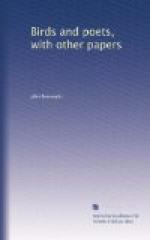“Here
was this atom in full breath,
Hurling
defiance at vast death;
This
scrap of valor just for play
Fronts
the north-wind in waistcoat gray,
As
if to shame my weak behavior;
I
greeted loud my little savior,
’You
pet! what dost here? and what for?
In
these woods, thy small Labrador,
At
this pinch, wee San Salvador!
What
fire burns in that little chest,
So
frolic, stout, and self-possest?
Henceforth
I wear no stripe but thine;
Ashes
and jet all hues outshine.
Why
are not diamonds black and gray,
To
ape thy dare-devil array?
And
I affirm, the spacious North
Exists
to draw thy virtue forth.
I
think no virtue goes with size;
The
reason of all cowardice
Is,
that men are overgrown,
And,
to be valiant, must come down
To
the titmouse dimension.’
. . . . . . . .
“I think old Caesar must have heard In northern Gaul my dauntless bird, And, echoed in some frosty wold, Borrowed thy battle-numbers bold. And I will write our annals new And thank thee for a better clew. I, who dreamed not when I came here To find the antidote of fear, Now hear thee say in Roman key, Poean! Veni, vidi, vici."
A late bird-poem, and a good one of its kind, is Celia Thaxter’s “Sandpiper,” which recalls Bryant’s “Water-Fowl” in its successful rendering of the spirit and atmosphere of the scene, and the distinctness with which the lone bird, flitting along the beach, is brought before the mind. It is a woman’s or a feminine poem, as Bryant’s is characteristically a man’s.
The sentiment or feeling awakened by any of the aquatic fowls is preeminently one of loneliness. The wood duck which your approach starts from the pond or the marsh, the loon neighing down out of the April sky, the wild goose, the curlew, the stork, the bittern, the sandpiper, awaken quite a different train of emotions from those awakened by the land-birds. They all have clinging to them some reminiscence and suggestion of the sea. Their cries echo its wildness and desolation; their wings are the shape of its billows.
Of the sandpipers there are many varieties, found upon the coast and penetrating inland along the rivers and water-courses, one of the most interesting of the family, commonly called the “tip-up,” going up all the mountain brooks and breeding in the sand along their banks; but the characteristics are the same in all, and the eye detects little difference except in size.
The walker on the beach sees it running or flitting before him, following up the breakers and picking up the aquatic insects left on the sands; and the trout-fisher along the farthest inland stream likewise intrudes upon its privacy. Flitting along from stone to stone seeking its food, the hind part of its body “teetering” up and down, its soft gray color blending it with the pebbles and the rocks, or else skimming up or down the stream on its long, convex wings, uttering its shrill cry, the sandpiper is not a bird of the sea merely; and Mrs. Thaxter’s poem is as much for the dweller inland as for the dweller upon the coast:—




